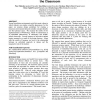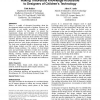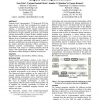199 search results - page 6 / 40 » Physical programming: designing tools for children to create... |
CHI
2006
ACM
14 years 8 months ago
2006
ACM
Our current understanding of human interaction with hybrid or augmented environments is very limited. Here we focus on `tangible interaction', denoting systems that rely on e...
CORR
2010
Springer
13 years 5 months ago
2010
Springer
Virtual human simulation integrated into virtual reality applications is mainly used for virtual representation of the user in virtual environment or for interactions between the ...
ACMIDC
2008
13 years 9 months ago
2008
Several simulation environments exist that create a place in which students can explore scientific phenomena. In this paper, we propose design guidelines for creating a classroom ...
CHI
2011
ACM
12 years 11 months ago
2011
ACM
There is a wealth of theoretical knowledge about the developmental abilities and skills of children. However, this knowledge is not readily accessible to designers of interactive ...
TEI
2009
ACM
14 years 2 months ago
2009
ACM
Drawing on the ‘representation’ TUI framework [21], this paper reports a study that investigated the concept of ‘representation location’ and its effect on interaction and...



